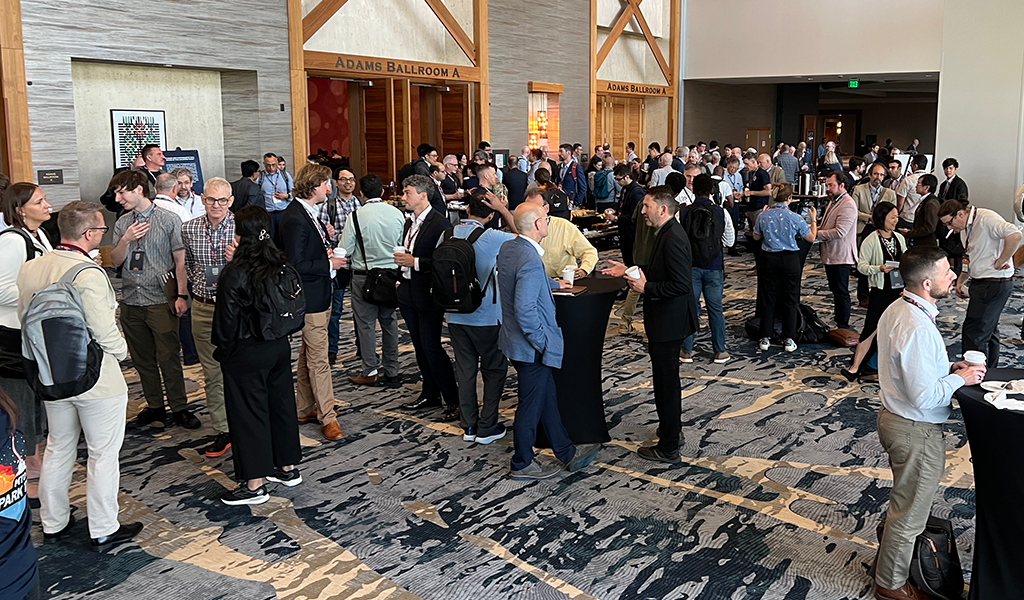Light the Spark, Watch it Grow…
In the summer of 2025, DARPA’s Microsystems Technology Office (MTO) convened approximately 400 participants from across the nation’s R&D ecosystem for its inaugural Spark Tank and Pitch Day events, in Aurora, Colorado.
Why? To expand and deepen MTO’s engagement with innovators, de-mystify working with DARPA, and ignite bold new ideas in microsystems.
Spark Tank | Pitch Day | Snapshots | RFIs
Spark Tank
MTO Spark Tank welcomed attendees from 222 unique organizations, with nearly half representing small businesses. The event was designed as a launchpad for researchers, entrepreneurs, and technologists to connect directly with MTO leadership and program managers.

Throughout the two-day event, attendees gained firsthand insight into MTO’s technical priorities and the broader DARPA ecosystem through:
- Briefings from the MTO program managers (PMs) on areas of interest across photonics, quantum, and biologically-inspired microsystems
- Seven new RFIs announced by MTO PMs, offering early looks at the emerging ideas that the PMs are interested in exploring in the coming year
- One-on-one “sidebar” meetings with program managers to explore alignment and potential collaborations
- Tips on working with DARPA, featuring insights from DARPA’s Small Business, Commercial Strategy, and Contract Management Offices
- Networking opportunities, including “Lunch with the PMs,” multiple breaks, and a lively Thursday evening social

Index

Pitch Day
Running alongside Spark Tank, the invitation-only MTO Pitch Day gave selected teams the chance to pitch transformative ideas directly to MTO program managers, with up to $400,000 in rapid-turnaround funding on the line.
DARPA invited abstract submissions in three technical areas of interest:
- Unconventional Computing: New paradigms beyond traditional digital computing, with the potential to improve speed, energy efficiency, and processing capabilities
- Biologically Inspired Microsystems: Electronic microsystems that integrate biomolecules and leverage biological principles for superior sensing and computation capabilities
- Commercially Catalyzed Defense Deployment: Commercial-scale technologies that can enhance national security and create a self-sustaining ecosystem for accelerating defense-specific microsystem deployment
From over 100 abstracts submitted, 36 teams were invited to deliver a seven-minute pitch. Evaluation and funding decisions were made on-site through collaborative review among program managers and leadership. Selectees were notified by day’s end, with formal awards issued the following week.
Fast Facts:
- 19 teams received awards of $400,000 (8 months) or $200,000 (4 months)
- Over 70% had never worked with DARPA
- Nearly half were small businesses; another 42% came from universities
- 31% had never received any government funding before
Awardees
The following organizations were selected for Pitch Day awards:
- Beacon Photonics
- Colorado School of Mines
- Draper
- Duke University
- EdgeDyne, LLC
- Flari Tech Inc.
- Great Sky Inc.
- Hewlett Packard Enterprise
- Hipposmith
- Kepler Computing Inc.
- Lux Semiconductors
- Massachusetts Institute of Technology
- North Carolina State University*
- SRI International
- The University of Alabama
- University of California, Los Angeles
- University of Wisconsin-Madison
- Vescent Technologies, Inc.
*Two distinct teams from North Carolina State University were selected for separate awards.
Snapshots
RFIs From the Minds of MTO Program Managers
Each Request for Information reflects the emerging ideas that MTO program managers are interested in exploring in the year ahead: new directions, bold concepts, and potential seeds of future MTO programs.
Full details and descriptions for each RFI can be found on SAM.gov. And for additional concepts and lines of thought from the MTO program managers, please check out the MTO Ideas Under Incubation.
- American Made Microsystems: Seeks information on domestically manufactured products and processes applicable to, but not yet utilized in, microsystems. DARPA is interested in identifying an untapped microsystem lifecycle for American-made products within its industrial base.
- Microelectronics Black Start: Seeks information on rapid, remote microelectronics manufacturing deployment (black-start), repurposing existing microelectronics supplies for rapid capacity establishment (brown-start), and/or replacing traditional microelectronics with unconventional technologies to create an alternative ecosystem (clean-slate).
- NGMM Design: Seeks identification of innovative applications that can leverage 3DHI, organizations interested in utilizing NGMM’s 3DHI capability, potential barriers to fabricating 3DHI components, and/or additional offerings that would further promote both the use of 3DHI and engagement with NGMM.
- Quantum Manufacturing: Seeks information on manufacturing metrics, economic frameworks, business development strategies, novel manufacturable sensing architectures, supporting technologies, novel manufacturing technologies, and processes to enable a future vision of economically sustained domestic manufacturing of advanced quantum sensors.
- Chemically and Biologically Enhanced Microsystems: Seeks information on challenges, new approaches, and potential impacts of chemical and biological interactions with microsystems. DARPA is interested in microsystems that not only survive chemically and biologically harsh treatments but are enhanced by them.
- Molecular Machines: Seeks information on molecular machines, templated synthesis, and biologically-inspired approaches for sequence-defined macromolecules, novel organic, inorganic, or hybrid polymers, desired system characteristics and performance metrics, and analytical testing approaches to enable asymmetric technologies and advanced materials.
- Quantum Sensor Processing: Seeks information on the photonic integrated circuit (PIC) needs of quantum technology companies, particularly for systems based on quantum resources such as neutral atoms, trapped ions, color centers, quantum dots, or other matter-based quantum resources, hereafter referred to as “quantum emitters."

